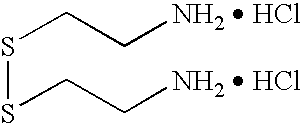Photo-formed metal nanoparticles and aerogel materials comprising the same
a technology of aerogel materials and metal nanoparticles, which is applied in the direction of catalyst activation/preparation, metal/metal-oxide/metal-hydroxide catalysts, etc., can solve the problems of nanoparticle size and other issues
- Summary
- Abstract
- Description
- Claims
- Application Information
AI Technical Summary
Problems solved by technology
Method used
Image
Examples
example 1
[0043] A mixture of 12.5 ml of tetraethylorthoxilicate (TEOS), 40 ml of an aqueous solution containing 1% wt % of 80% deacylated chitosan (Fluka molecular weight 2,000,000 Dalton) and 1 wt % acetic acid and 0.9 ml of glacial acetic acid was prepared and stirred at room temperature for 8 hours. A clear, colorless and viscous solution formed. Portions were poured into polystyrene boxes (2 inch by 2 inch and about 1 inch high). They gelled as films and were aged for 12 hours. A solution (ca.5 ml) of absolute ethanol and ammonium hydroxide (40:1 v / v) was added into the gel. Then the supernatant solution and liquid in the gel were replaced with absolute ethanol by exchanging the supernatant at least for 5-8 times during a period of 5-8 days to produce full wet gels containing ethanol. The gels were subjected to supercritical fluid extraction (SCE) with carbon dioxide CO2 under supercritical condition, typically P=1400 Psi and temperature at 36° C. This produced an aerogel with about 10% ...
example 2
[0044] Wet gels produced in Example 1 were treated to one more step before SCE in which the supernatant ethanol was replaced by a solution made by dissolving HAuCl4 in ethanol. By controlling the stoichiometric ratio between Au(III) and the amine containing groups present in the chitosan in gel, gels with different gold concentrations were obtained. In one set of experiments, gels with ca. 10% X were treated with HAuCl4 to obtain gels. The ratio of Au(III) / NH2-containing groups (abbreviated as Au(III) / NH2 herein) was varied from about 1:120 to 1:5 with specific values of 1:90, 1:60, 1:30, 1:15 and 1:5 in this example. Following supercritical fluid extraction by carbon dioxide, clear, yellow monolithic pieces of these aerogels, labeled as X—SiO2—Au(III) and specified by Au(III) / NH2 ratio were obtained. Infrared spectra showed that Au(III) was coordinated to amine groups of chitosan in the aerogel.
example 3
[0045] A clear yellow monolithic or powdered aerogel produced in Example 2 was put in an aluminum tray and was exposed in air for 8 hours to UV light about 10 cm from a GE G25T8 low pressure Hg arc lamp with a quartz envelope. Over 95% of the lamp output is at 254 nm. The power of the radiation at the aerogel was less than 20 mW / cm2. The clear yellow aerogel turned to red color after the exposure. Infrared and UV-Visible spectral properties of this material were studied. TEM also was used to study the gold nanoparticles. A characteristic plasmon resonance absorption peak for gold nanoparticles appeared in the UV-Vis spectra near 520 nm. After UV exposure, absorption (shoulder) appeared at about 1700 cm−1, which is interpreted as being due to species produced by oxidation of an organic entity, possibly the chitosan in the aerogel. TEM pictures showed gold nanoparticles dispersed in the aerogel matrix. The mean gold sizes varied from 8 nm to 85 nm.
PUM
| Property | Measurement | Unit |
|---|---|---|
| particle size | aaaaa | aaaaa |
| particle size | aaaaa | aaaaa |
| size | aaaaa | aaaaa |
Abstract
Description
Claims
Application Information
 Login to View More
Login to View More - R&D
- Intellectual Property
- Life Sciences
- Materials
- Tech Scout
- Unparalleled Data Quality
- Higher Quality Content
- 60% Fewer Hallucinations
Browse by: Latest US Patents, China's latest patents, Technical Efficacy Thesaurus, Application Domain, Technology Topic, Popular Technical Reports.
© 2025 PatSnap. All rights reserved.Legal|Privacy policy|Modern Slavery Act Transparency Statement|Sitemap|About US| Contact US: help@patsnap.com



